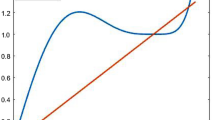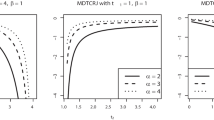Abstract
In this paper, a new extrinsic information scaling and early stopping mechanism for long term evolution (LTE) turbo code is proposed. A scaling factor is obtained by computing the Pearson’s correlation coefficient between the extrinsic and a posteriori log-likelihood ratio (LLR) at every half-iteration. Additionally, two new stopping criteria are proposed. The first one uses the regression angle which is computed at each half-iteration and is applied at low E b/N 0. The second one uses Pearson’s correlation coefficient and is applicable for high E b/N 0 values. The performance of the proposed scheme was compared against an existing scaling and stopping mechanism based on the sign difference ratio (SDR) technique as well as conventional LTE turbo code. Simulations have been performed with both quadrature phase shift keying (QPSK) modulation and 16-quadrature amplitude modulation (QAM) together with code rates of 1/3 and 1/2. The results demonstrate that the proposed scheme outperforms both the conventional scheme and that employing the SDR-based scaling and stopping mechanism in terms of BER performance and average number of decoding iterations. The performance analysis using EXIT charts for each scheme shows higher initial output mutual information for input mutual information of zero. Better convergence is also demonstrated with the wider tunnel for the proposed scheme. Additionally, the computational complexity analysis demonstrates a significant gain in terms of the average number of computations per packet with the different modulation and coding schemes while still gaining in terms of error performance.

























Similar content being viewed by others
References
Berrou C, Glavieux A and Thitimajshima P (1993) Near Shannon limit error-correcting coding and decoding, in IEEE International Conference on Communications, ICC 93, Geneva
Seisa S, Toufik I and Baker M, (2009) LTE—the UMTS long term evolution: from theory to practice, John Wiley and Sons Ltd
3GPP (2009) Technical specifications Rel. 8, 3GPP
3GPP2 C.S0024-B: ‘CDMA (2000) high rate packet data air interface specification’ Version 1.0, May 2006. [Online]. Available: http://www.3gpp2.org/Public_html/specs/C.S0024-B_v1.0_060522.pdf. [Accessed November 2006]
Zyren J (2010) “Home Plug Green PHY overview, technical paper,” Atheros Communications
Chellali S, Chouireb F (2015) A d-dimensional irregular compact interleaver design for turbo code. Ann Telecommun 70(5–6):233–237
Ortin J, Ducar PG, Gutiérrez F, Valdovinos A (2014) An efficiently implementable maximum likelihood decoding algorithm for tailbiting codes. Ann Telecommun 69(9–10):529–537
Trifina L, Tarniceriu D (2014) Improved method for searching interleavers from a certain set using Garello’s method with applications for the LTE standard. Ann Telecommun 69(5–6):251–272
Vogt J, Finger A (2000) Improving the MAX-Log-MAP turbo decoder. Electr Lett 36(23):1937–1939
Gnanasekaran T, Duraiswamy K (2009) Application of scaling factors for MAP and SOVA for robust performance in forward error correction. Int J Recent Trends Eng 1(3):47–51
Wu Y, Woerner B, Ebel J (2000) A simple stopping criterion for turbo decoding. IEEE Commun Lett 4(8):258–260
Lin Y, Humg W, Lin W, Chen T and Lu E, (2006) An efficient soft-input scaling scheme for turbo decoding, in IEEE International Conference on Sensor Networks, Ubiquitous, and Trustworthy Computing Workshops
Fowdur TP, Beeharry Y, Soyjaudah KMS (2013) Performance of LTE turbo codes with joint source channel decoding, adaptive scaling and prioritized QAM constellation mapping. Int J Ad Telecommun 6(3 & 4):143–152
Fowdur TP, Beeharry Y and Soyjaudah KMS (2014) Performance of modified asymmetric LTE turbo codes with Reliability-Based Hybrid ARQ, in Proc. of 9th IEEE/IET Symposium on Communication Systems, Networks and Digital Signal Processing, CSNDSP 2014, Manchester, Metropolitan University, United Kingdom
Fowdur TP, Beeharry Y, Soyjaudah KMS (2013) Performance of turbo coded 64-QAM with joint source channel decoding, adaptive scaling and prioritised constellation mapping, in 6th International Conference on Communication Theory, Reliability and Quality of Service, CTRQ 2013. Venice, Italy
El-Khamy M, Wu J, Lee J, Kang I (2014) Online log-likelihood ratio scaling for robust turbo decoding. IET Commun 8(2):217–226
IInseher T, Kienle F, Weis C and Wehn N (2012) A 2.15GBit/s turbo code decoder for LTE advanced base station applications, in 7th International Symposium on Turbo Codes and Iterative Information Processing (ISTC), Gothenburg
Alberge F (2015) On some properties of the mutual information between extrinsics with application to iterative decoding. IEEE Trans Commun 63(5):1541–1553
Li F, Wu A (2007) On the new stopping criteria of iterative turbo decoding by using decoding threshold. IEEE Trans on Signal Proc 55(11):5506–5516
Wang Z, Suzuki H and Parhi KK (1999) VLSI implementation issues of turbo decoder design for wireless applications, Proc. of IEEE Workshop Signal Process. Syst., pp. 503–512
Hagenauer J, Offer E, Papke L (1996) Iterative decoding of binary block and convolutional codes. IEEE Trans Inf Theory 42(2):429–445
Shao RY, Lin S, Fossorier MPC (1999) Two simple stopping criteria for turbo decoding. IEEE Trans Commun 47(8):1117–1120
Guerrieri L, Veronesi D and Bisaglia P (2008) Stopping rules for duo-binary turbo codes and applications to HomePlug AV, in Global Telecommunications Conference GLOBECOM, IEEE, New Orleans
Shan L, Lei X, Huifang C and Kuang W, (2010) A new stopping criteria for duo-binary turbo codes, in International Conference on Communications and Mobile Computing (CMC), Shenzen
Cheng-Hung L, Chih-Chia W (2013) Efficient window-based stopping technique for double-binary turbo decoding. IEEE Commun Lett 17(1):169–172
Fowdur TP, Soyjaudah KMS (2008) Performance of joint source-channel decoding with iterative bit-combining and detection. Ann Telecommun 63(7–8):409–423
Vucetic B, Yuan J (2000) Turbo codes: principles and applications. Kluwer Academic Publishers Norwell
Wang Z, Zhang Y and Parhi KK (2006) Study of early stopping criteria for turbo decoding and their applications in WCDMA systems, in Proc. of IEEE International Conference on Acoustics, Speech and Signal Processing (ICASSP), Toulouse
Gnanasekaran T and Aarthi V (2010) Performance enhancement of modified Log MAP decoding algorithm for turbo codes, in International Conference on Communication & Computational Intelligence (INCOCCI 2010), Erode
Taskaldiran M, Morling RCSand Kale I (2007) A comparative study on the modified Max-Log-MAP turbo decoding by extrinsic information scaling in Wireless Telecommunications Symposium (WTS 2007), Pomoca, CA
Lowry R (2014) Concepts and applications of inferential statistics, 1998–2013. [Online]. Available: http://vassarstats.net/textbook/. [Accessed 24 November 2014].
Farchane A, Belkasmi M, Azouaoui A (2013) EXIT chart for iterative decoding of product and concatenated block codes. Int J Comput Scie Iss 10(4):68–77
Acknowledgments
The technical support of the University of Mauritius and the Tertiary Education Commission of Mauritius is duly acknowledged.
Author information
Authors and Affiliations
Corresponding author
Rights and permissions
About this article
Cite this article
Fowdur, T.P., Beeharry, Y. & Soyjaudah, K.M.S. A novel scaling and early stopping mechanism for LTE turbo code based on regression analysis. Ann. Telecommun. 71, 369–388 (2016). https://doi.org/10.1007/s12243-016-0514-y
Received:
Accepted:
Published:
Issue Date:
DOI: https://doi.org/10.1007/s12243-016-0514-y




